金融机构管理第十章中文版课后习题答案(1-8、19)
金融机构管理第九章中文版课后习题答案(1、2、3、6、11、12、13、16)

金融机构管理第九章课后习题部分答案(1、2、3、6、11、12、13、16)1. 有效期限衡量的是经济定义中资产和负债的平均期限。
有效期限的经济含义是资产价值对于利率变化的利率敏感性(或利率弹性)。
有效期限的严格定义是一种以现金流量的相对现值为权重的加权平均到期期限。
有效期限与到期期限的不同在于,有效期限不仅考虑了资产(或负债)的期限,还考虑了期间发生的现金流的再投资利率。
2.息票债券面值价值= $1,00利率= 0.10 每年付一次息到期收益率=0.08 期限= 2时间现金流PVIF PV ofCF PV*CF *T1 $100.00 0.92593$92.59 $92.592 $1,100.00 0.85734$943.07 $1,886.15价格=$1,035.67分子= $1,978.74有效期限=1.9106= 分子/价格到期收益率=0.10时间现金流PVIF PV ofCF PV*CF *T1 $100.00 0.90909$90.91 $90.912 $1,100.00 0.82645$909.09 $1,818.18价格=$1,000.00分子= $1,909.09有效期限=1.9091= 分子/价格到期收益率=0.12时间现金流PVIF PV ofCF PV*CF *T1 $100.00 0.892$89.29 $89.292 $1,100.00 0.79719$876.91 $1,753.83价格=$966.20分子= $1,843.11有效期限=1.9076= 分子/价格b. 到期收益率上升时,有限期限减少。
c.零息债券面值价值= $1,00利率= 0.00到期收益率=0.08 期限= 2时间现金流PVIF PV ofCF PV*CF *T1 $0.00 0.92593$0.00 $0.002 $1,000.00 0.85734$857.34 $1,714.68价格=$857.34分子= $1,714.68有效期限=2.000= 分子/价格到期收益率=0.10时间现金流PVIF PV ofCF PV*CF *T1 $0.00 0.90909$0.00 $0.002 $1,000.00 0.82645$826.45 $1,652.89价格=$826.45分子= $1,652.89有效期限=2.000= 分子/价格到期收益率=0.12时间现金流PVIF PV ofCF PV*CF *T1 $0.00 0.892$0.00 $0.002 $1,000.00 0.79719 $797.19 $1,594.39价格 = $797.19分子 =$1,594.39有效期限 =2.0000= 分子/价格d.到期收益率的变化不影响零息债券的有效期限。
金融监管学 习题答案第10章
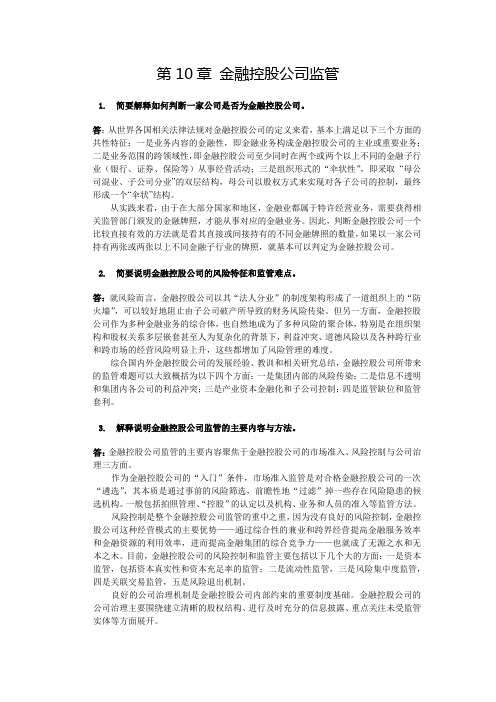
第10章金融控股公司监管1.简要解释如何判断一家公司是否为金融控股公司。
答:从世界各国相关法律法规对金融控股公司的定义来看,基本上满足以下三个方面的共性特征:一是业务内容的金融性,即金融业务构成金融控股公司的主业或重要业务;二是业务范围的跨领域性,即金融控股公司至少同时在两个或两个以上不同的金融子行业(银行、证券、保险等)从事经营活动;三是组织形式的“伞状性”,即采取“母公司混业、子公司分业”的双层结构,母公司以股权方式来实现对各子公司的控制,最终形成一个“伞状”结构。
从实践来看,由于在大部分国家和地区,金融业都属于特许经营业务,需要获得相关监管部门颁发的金融牌照,才能从事对应的金融业务。
因此,判断金融控股公司一个比较直接有效的方法就是看其直接或间接持有的不同金融牌照的数量,如果以一家公司持有两张或两张以上不同金融子行业的牌照,就基本可以判定为金融控股公司。
2.简要说明金融控股公司的风险特征和监管难点。
答:就风险而言,金融控股公司以其“法人分业”的制度架构形成了一道组织上的“防火墙”,可以较好地阻止由子公司破产所导致的财务风险传染。
但另一方面,金融控股公司作为多种金融业务的综合体,也自然地成为了多种风险的聚合体,特别是在组织架构和股权关系多层嵌套甚至人为复杂化的背景下,利益冲突、道德风险以及各种跨行业和跨市场的经营风险明显上升,这些都增加了风险管理的难度。
综合国内外金融控股公司的发展经验、教训和相关研究总结,金融控股公司所带来的监管难题可以大致概括为以下四个方面:一是集团内部的风险传染;二是信息不透明和集团内各公司的利益冲突;三是产业资本金融化和子公司控制;四是监管缺位和监管套利。
3.解释说明金融控股公司监管的主要内容与方法。
答:金融控股公司监管的主要内容聚焦于金融控股公司的市场准入、风险控制与公司治理三方面。
作为金融控股公司的“入门”条件,市场准入监管是对合格金融控股公司的一次“遴选”,其本质是通过事前的风险筛选,前瞻性地“过滤”掉一些存在风险隐患的候选机构。
西财《金融理财》教学资料 课后习题答案 第十章
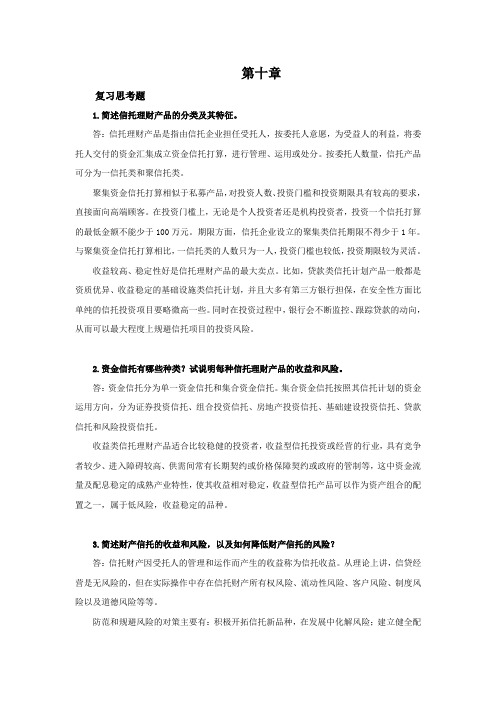
第十章复习思考题1.简述信托理财产品的分类及其特征。
答:信托理财产品是指由信托企业担任受托人,按委托人意愿,为受益人的利益,将委托人交付的资金汇集成立资金信托打算,进行管理、运用或处分。
按委托人数量,信托产品可分为一信托类和聚信托类。
聚集资金信托打算相似于私募产品,对投资人数、投资门槛和投资期限具有较高的要求,直接面向高端顾客。
在投资门槛上,无论是个人投资者还是机构投资者,投资一个信托打算的最低金额不能少于100万元。
期限方面,信托企业设立的聚集类信托期限不得少于1年。
与聚集资金信托打算相比,一信托类的人数只为一人,投资门槛也较低,投资期限较为灵活。
收益较高、稳定性好是信托理财产品的最大卖点。
比如,贷款类信托计划产品一般都是资质优异、收益稳定的基础设施类信托计划,并且大多有第三方银行担保,在安全性方面比单纯的信托投资项目要略微高一些。
同时在投资过程中,银行会不断监控、跟踪贷款的动向,从而可以最大程度上规避信托项目的投资风险。
2.资金信托有哪些种类?试说明每种信托理财产品的收益和风险。
答:资金信托分为单一资金信托和集合资金信托。
集合资金信托按照其信托计划的资金运用方向,分为证券投资信托、组合投资信托、房地产投资信托、基础建设投资信托、贷款信托和风险投资信托。
收益类信托理财产品适合比较稳健的投资者,收益型信托投资或经营的行业,具有竞争者较少、进入障碍较高、供需间常有长期契约或价格保障契约或政府的管制等,这中资金流量及配息稳定的成熟产业特性,使其收益相对稳定,收益型信托产品可以作为资产组合的配置之一,属于低风险,收益稳定的品种。
3.简述财产信托的收益和风险,以及如何降低财产信托的风险?答:信托财产因受托人的管理和运作而产生的收益称为信托收益。
从理论上讲,信贷经营是无风险的,但在实际操作中存在信托财产所有权风险、流动性风险、客户风险、制度风险以及道德风险等等。
防范和规避风险的对策主要有:积极开拓信托新品种,在发展中化解风险;建立健全配套制度,加强内部管理和外部监督制约机制等。
《金融风险管理》课后习题答案
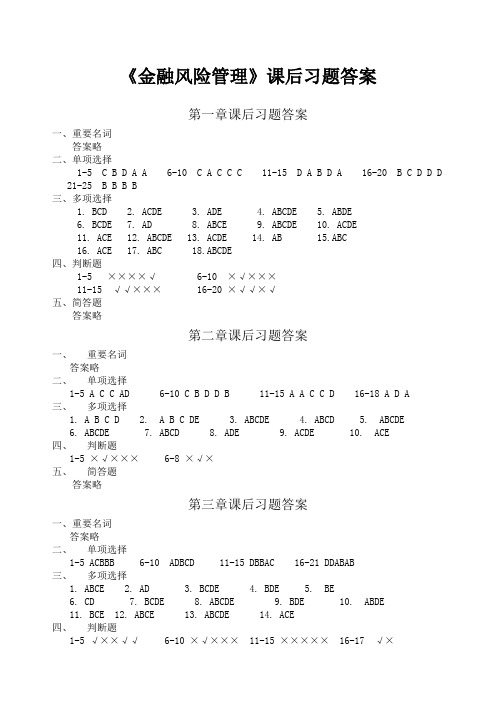
《金融风险管理》课后习题答案第一章课后习题答案一、重要名词答案略二、单项选择1-5 C B D A A 6-10 C A C C C 11-15 D A B D A 16-20 B C D D D 21-25 B B B B三、多项选择1. BCD2. ACDE3. ADE4. ABCDE5. ABDE6. BCDE7. AD8. ABCE9. ABCDE 10. ACDE11. ACE 12. ABCDE 13. ACDE 14. AB 15.ABC16. ACE 17. ABC 18.ABCDE四、判断题1-5 ××××√ 6-10 ×√×××11-15 √√××× 16-20 ×√√×√五、简答题答案略第二章课后习题答案一、重要名词答案略二、单项选择1-5 A C C AD 6-10 C B D D B 11-15 A A C C D 16-18 A D A三、多项选择1. A B C D2. A B C DE3. ABCDE4. ABCD5. ABCDE6. ABCDE7. ABCD8. ADE9. ACDE 10. ACE四、判断题1-5 ×√××× 6-8 ×√×五、简答题答案略第三章课后习题答案一、重要名词答案略二、单项选择1-5 ACBBB 6-10 ADBCD 11-15 DBBAC 16-21 DDABAB三、多项选择1. ABCE2. AD3. BCDE4. BDE5. BE6. CD7. BCDE8. ABCDE9. BDE 10. ABDE11. BCE 12. ABCE 13. ABCDE 14. ACE四、判断题1-5 √××√√ 6-10 ×√××× 11-15 ××××× 16-17 √×五、简答题答案略第四章课后习题答案二、单选1-5DCCAD 6-10AAABA 11-15DDCCB 15-20A ABBD三、多选1-5BCDE/CD / ABDE /ABCE /ABCDE 6-10ABCD/ ABCDE/ ABDE/CD/AC11-15ABCDE /ABCE/ACD/ABC/ABCD16-20ABCE/ABE/ABCDE/ABCDE/BCDE四、判断题1-5 错错错错错 6-10对对错对对 11-15对对对错对 16-18错错对第五章课后习题答案一、重要名词答案略二、单项选择1-5 ACCBB 6-10 ADDCD 11-15 CCBCD 16-20 ACDCC 21-25 CDBAC 26-30 DABBD 31-35 ABCAB 36-40 DACAB 41-45 CDAAC 46-48 AAD三、多项选择1. ABC2. ABD3. BCE4. AC5. BC6. BCE7. DE8. ADE9. ABCD 10. ABCD11. ABD 12. ABCD 13. ABC 14. ABCD 15. BC16. AB 17. ABCD 18. AC 19. AD 20. BCD21. CD 22. CD 23. AB四、判断题1-5 √×××√ 6-10 ××√×× 11-15 ××××√ 16-20 √××××21-25 √×√×× 26-30 ×√××× 31-35 ×√××× 36-40 √×√√√ 41-45 ××√√√ 46-47 ×√五、简答题答案略第六章课后习题答案二、单选1-5DCCAD 6-10AAABA 11-15DDCCB 15-20A ABBD四、多选1-5BCDE/CD / ABDE /ABCE /ABCDE 6-10ABCD/ ABCDE/ ABDE/CD/AC11-15ABCDE /ABCE/ACD/ABC/ABCD16-20ABCE/ABE/ABCDE/ABCDE/BCDE五、判断题1-5 错错错错错 6-10对对错对对 11-15对对对错对 16-18错错对第七章课后习题答案一、重要名词答案略二、单项选择1-5 BCDCA 6-10 BBDDD 11-15 CADCC三、多项选择1. ABCDE2. CDE3. ABCDE4. ABCDE5. BCE6. BDE7. ABCE8. BCE9. ABC 10. ABDE11. ABCDE 12. ABD 13. ABCD四、判断题1-10√××√××√×√五、案例分析题案例1:内部欺诈(未经授权交易导致资金损失)案例2:失职违规案例3:核心雇员流失案例4:违反用工发六、简答题答案略第八章课后习题答案一、重要名词答案略二、单项选择1-5 CDCCB 6-10 DCDAB 11-15 CADAA 16-20 DACCC三、多项选择1. ACE2. ABE3. ABCE4. ADE5. ABE6. ABCD7. ABCDE8.ABCD9. ABCD 10. ABC四、判断题1-11××√××√××√√五、简答题答案略第九章课后习题答案一、重要名词答案略二、单项选择1-5 ABDDD 6-10 AABBD 11-16 CCDDAB三、多项选择1. ABCD2. ABCD3. AC4. BCD5. ABCD6. ABCDE7. ACD8. ABCDE9. ABCDE 10. ABCDE四、判断题1-5 ×√××√ 6-10 √×√×× 11-14 √√√√五、简答题答案略第十章课后习题答案一、重要名词答案略二、单项选择1-5 ABBCB 6-10 CCBDA三、多项选择1. CD2. ADE3. AC4. BCDE5. CDE6.ABC7. ACE8. ABC9. ACDE 10.ABC四、判断题1-5 ×××√×五、简答题答案略第十一章课后习题答案二、单选题1-5DABCB 6-10DABDC 11-15DBAAB 16-20DCCAA三、多选题1-5ABD/ACD/AC/ABC/ACD 6-10 ABCD/ABD/ABCDE/ABCDE/ABCDE11-15ABCDE/ABCDE/ABCD/ABCDE/ABCDE16-20ACD/ ABCDE/ABCDE/ ACE/ADE四、1-5对错错对对 6-10对错对对错 11-15对对对对错 16-20对错对错对。
Chap002金融机构管理课后题答案
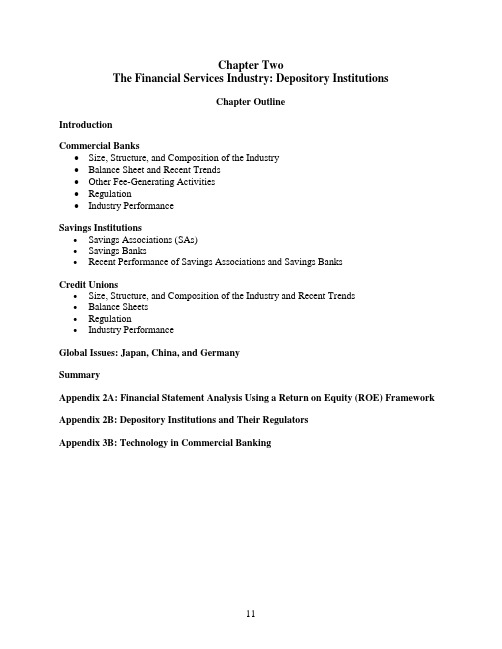
Chapter TwoThe Financial Services Industry: Depository InstitutionsChapter OutlineIntroductionCommercial Banks∙Size, Structure, and Composition of the Industry∙Balance Sheet and Recent Trends∙Other Fee-Generating Activities∙Regulation∙Industry PerformanceSavings Institutions∙Savings Associations (SAs)∙Savings Banks∙Recent Performance of Savings Associations and Savings BanksCredit Unions∙Size, Structure, and Composition of the Industry and Recent Trends∙Balance Sheets∙Regulation∙Industry PerformanceGlobal Issues: Japan, China, and GermanySummaryAppendix 2A: Financial Statement Analysis Using a Return on Equity (ROE) Framework Appendix 2B: Depository Institutions and Their RegulatorsAppendix 3B: Technology in Commercial BankingSolutions for End-of-Chapter Questions and Problems: Chapter Two1.What are the differences between community banks, regional banks, and money-centerbanks? Contrast the business activities, location, and markets of each of these bank groups. Community banks typically have assets under $1 billion and serve consumer and small business customers in local markets. In 2003, 94.5 percent of the banks in the United States were classified as community banks. However, these banks held only 14.6 percent of the assets of the banking industry. In comparison with regional and money-center banks, community banks typically hold a larger percentage of assets in consumer and real estate loans and a smaller percentage of assets in commercial and industrial loans. These banks also rely more heavily on local deposits and less heavily on borrowed and international funds.Regional banks range in size from several billion dollars to several hundred billion dollars in assets. The banks normally are headquartered in larger regional cities and often have offices and branches in locations throughout large portions of the United States. Although these banks provide lending products to large corporate customers, many of the regional banks have developed sophisticated electronic and branching services to consumer and residential customers. Regional banks utilize retail deposit bases for funding, but also develop relationships with large corporate customers and international money centers.Money center banks rely heavily on nondeposit or borrowed sources of funds. Some of these banks have no retail branch systems, and most regional banks are major participants in foreign currency markets. These banks compete with the larger regional banks for large commercial loans and with international banks for international commercial loans. Most money center banks have headquarters in New York City.e the data in Table 2-4 for the banks in the two asset size groups (a) $100 million-$1billion and (b) over $10 billion to answer the following questions.a. Why have the ratios for ROA and ROE tended to increase for both groups over the1990-2003 period? Identify and discuss the primary variables that affect ROA andROE as they relate to these two size groups.The primary reason for the improvements in ROA and ROE in the late 1990s may berelated to the continued strength of the macroeconomy that allowed banks to operate with a reduced regard for bad debts, or loan charge-off problems. In addition, the continued low interest rate environment has provided relatively low-cost sources of funds, and a shifttoward growth in fee income has provided additional sources of revenue in many product lines. Finally, a growing secondary market for loans has allowed banks to control the size of the balance sheet by securitizing many assets. You will note some variance inperformance in the last three years as the effects of a softer economy were felt in thefinancial industry.b. Why is ROA for the smaller banks generally larger than ROA for the large banks?Small banks historically have benefited from a larger spread between the cost rate of funds and the earning rate on assets, each of which is caused by the less severe competition in the localized markets. In addition, small banks have been able to control credit risk moreefficiently and to operate with less overhead expense than large banks.c. Why is the ratio for ROE consistently larger for the large bank group?ROE is defined as net income divided by total equity, or ROA times the ratio of assets to equity. Because large banks typically operate with less equity per dollar of assets, netincome per dollar of equity is larger.d. Using the information on ROE decomposition in Appendix 2A, calculate the ratio ofequity-to-total-assets for each of the two bank groups for the period 1990-2003. Whyhas there been such dramatic change in the values over this time period, and why isthere a difference in the size of the ratio for the two groups?ROE = ROA x (Total Assets/Equity)Therefore, (Equity/Total Assets) = ROA/ROE$100 million - $1 Billion Over $10 BillionYear ROE ROA TA/Equity Equity/TA ROE ROA TA/Equity Equity/TA1990 9.95% 0.78% 12.76 7.84% 6.68% 0.38% 17.58 5.69%1995 13.48% 1.25% 10.78 9.27% 15.60% 1.10% 14.18 7.05%1996 13.63% 1.29% 10.57 9.46% 14.93% 1.10% 13.57 7.37%1997 14.50% 1.39% 10.43 9.59% 15.32% 1.18% 12.98 7.70%1998 13.57% 1.31% 10.36 9.65% 13.82% 1.08% 12.80 7.81%1999 14.24% 1.34% 10.63 9.41% 15.97% 1.28% 12.48 8.02%2000 13.56% 1.28% 10.59 9.44% 14.42% 1.16% 12.43 8.04%2001 12.24% 1.20% 10.20 9.80% 13.43% 1.13% 11.88 8.41%2002 12.85% 1.26% 10.20 9.81% 15.06% 1.32% 11.41 8.76%2003 12.80% 1.27% 10.08 9.92% 16.32% 1.42% 11.49 8.70% The growth in the equity to total assets ratio has occurred primarily because of theincreased profitability of the entire banking industry and the encouragement of theregulators to increase the amount of equity financing in the banks. Increased fee income, reduced loan loss reserves, and a low, stable interest rate environment have produced the increased profitability which in turn has allowed banks to increase equity through retained earnings.Smaller banks tend to have a higher equity ratio because they have more limited assetgrowth opportunities, generally have less diverse sources of funds, and historically have had greater profitability than larger banks.3.What factors have caused the decrease in loan volume relative to other assets on thebalance sheets of commercial banks? How has each of these factors been related to the change and development of the financial services industry during the 1990s and early2000s? What strategic changes have banks implemented to deal with changes in thefinancial services environment?Corporations have utilized the commercial paper markets with increased frequency rather than borrow from banks. In addition, many banks have sold loan packages directly into the capital markets (securitization) as a method to reduce balance sheet risks and to improve liquidity. Finally, the decrease in loan volume during the early 1990s and early 2000s was due in part to the recession in the economy.As deregulation of the financial services industry continued during the 1990s, the position of banks as the primary financial services provider continued to erode. Banks of all sizes have increased the use of off-balance sheet activities in an effort to generate additional fee income. Letters of credit, futures, options, swaps and other derivative products are not reflected on the balance sheet, but do provide fee income for the banks.4.What are the major uses of funds for commercial banks in the United States? What are theprimary risks to the bank caused by each use of funds? Which of the risks is most critical to the continuing operation of the bank?Loans and investment securities continue to be the primary assets of the banking industry. Commercial loans are relatively more important for the larger banks, while consumer, small business loans, and residential mortgages are more important for small banks. Each of these types of loans creates credit, and to varying extents, liquidity risks for the banks. The security portfolio normally is a source of liquidity and interest rate risk, especially with the increased use of various types of mortgage backed securities and structured notes. In certain environments, each of these risks can create operational and performance problems for a bank.5.What are the major sources of funds for commercial banks in the United States? How isthe landscape for these funds changing and why?The primary sources of funds are deposits and borrowed funds. Small banks rely more heavily on transaction, savings, and retail time deposits, while large banks tend to utilize large, negotiable time deposits and nondeposit liabilities such as federal funds and repurchase agreements. The supply of nontransaction deposits is shrinking, because of the increased use by small savers of higher-yielding money market mutual funds,6. What are the three major segments of deposit funding? How are these segments changingover time? Why? What strategic impact do these changes have on the profitable operation of a bank?Transaction accounts include deposits that do not pay interest and NOW accounts that pay interest. Retail savings accounts include passbook savings accounts and small, nonnegotiable time deposits. Large time deposits include negotiable certificates of deposits that can be resold in the secondary market. The importance of transaction and retail accounts is shrinking due to the direct investment in money market assets by individual investors. The changes in the deposit markets coincide with the efforts to constrain the growth on the asset side of the balance sheet.7. How does the liability maturity structure of a bank’s balance sheet compare with thematurity structure of the asset portfolio? What risks are created or intensified by thesedifferences?Deposit and nondeposit liabilities tend to have shorter maturities than assets such as loans. The maturity mismatch creates varying degrees of interest rate risk and liquidity risk.8. The following balance sheet accounts have been taken from the annual report for a U.S.bank. Arrange the accounts in balance sheet order and determine the value of total assets.Based on the balance sheet structure, would you classify this bank as a community bank, regional bank, or a money center bank?Assets Liabilities and EquityCash $ 2,660 Demand deposits $ 5,939Fed funds sold $ 110 NOW accounts $12,816Investment securities $ 5,334 Savings deposits $ 3,292Net loans $29,981 Certificates of deposit $ 9,853Intangible assets $ 758 Other time deposits $ 2,333Other assets $ 1,633 Short-term Borrowing $ 2,080Premises $ 1,078 Other liabilities $ 778Total assets $41,554 Long-term debt $ 1,191Equity $ 3,272Total liab. and equity $41,554This bank has funded the assets primarily with transaction and savings deposits. The certificates of deposit could be either retail or corporate (negotiable). The bank has very little ( 5 percent) borrowed funds. On the asset side, about 72 percent of total assets is in the loan portfolio, but there is no information about the type of loans. The bank actually is a small regional bank with $41.5 billion in assets, but the asset structure could easily be a community bank with $41.5 million in assets.9.What types of activities normally are classified as off-balance-sheet (OBS) activities?Off-balance-sheet activities include the issuance of guarantees that may be called into play at a future time, and the commitment to lend at a future time if the borrower desires.a. How does an OBS activity move onto the balance sheet as an asset or liability?The activity becomes an asset or a liability upon the occurrence of a contingent event,which may not be in the control of the bank. In most cases the other party involved with the original agreement will call upon the bank to honor its original commitment.b.What are the benefits of OBS activities to a bank?The initial benefit is the fee that the bank charges when making the commitment. If the bank is required to honor the commitment, the normal interest rate structure will apply to the commitment as it moves onto the balance sheet. Since the initial commitment does notappear on the balance sheet, the bank avoids the need to fund the asset with either deposits or equity. Thus the bank avoids possible additional reserve requirement balances anddeposit insurance premiums while improving the earnings stream of the bank.c.What are the risks of OBS activities to a bank?The primary risk to OBS activities on the asset side of the bank involves the credit risk of the borrower. In many cases the borrower will not utilize the commitment of the bank until the borrower faces a financial problem that may alter the credit worthiness of the borrower.Moving the OBS activity to the balance sheet may have an additional impact on the interest rate and foreign exchange risk of the bank.e the data in Table 2-6 to answer the following questions.a.What was the average annual growth rate in OBS total commitments over the periodfrom 1992-2003?$78,035.6 = $10,200.3(1+g)11 g = 20.32 percentb.Which categories of contingencies have had the highest annual growth rates?Category of Contingency or Commitment Growth RateCommitments to lend 14.04%Future and forward contracts 15.13%Notional amount of credit derivatives 52.57%Standby contracts and other option contracts 56.39%Commitments to buy FX, spot, and forward 3.39%Standby LCs and foreign office guarantees 7.19%Commercial LCs -1.35%Participations in acceptances -6.11%Securities borrowed 20.74%Notional value of all outstanding swaps 31.76%Standby contracts and other option contracts have grown at the fastest rate of 56.39 percent, and they have an outstanding balance of $214,605.3 billion. The rate of growth in thecredit derivatives area has been the second strongest at 52.57 percent, the dollar volumeremains fairly low at $1,001.2 billion at year-end 2003. Interest rate swaps grew at anannual rate of 31.76 percent with a change in dollar value of $41,960.7 billion. Clearly the strongest growth involves derivative areas.c.What factors are credited for the significant growth in derivative securities activities bybanks?The primary use of derivative products has been in the areas of interest rate, credit, andforeign exchange risk management. As banks and other financial institutions have pursuedthe use of these instruments, the international financial markets have responded byextending the variations of the products available to the institutions.11. For each of the following banking organizations, identify which regulatory agencies (OCC,FRB, FDIC, or state banking commission) may have some regulatory supervisionresponsibility.(a) State-chartered, nonmember, nonholding-company bank.(b)State-chartered, nonmember holding-company bank(c) State-chartered member bank(d)Nationally chartered nonholding-company bank.(e)Nationally chartered holding-company bankBank Type OCC FRB FDIC SBCom.(a) Yes Yes(b) Yes Yes Yes(c) Yes Yes Yes(d) Yes Yes Yes(e) Yes Yes Yes12. What factors normally are given credit for the revitalization of the banking industry duringthe decade of the 1990s? How is Internet banking expected to provide benefits in thefuture?The most prominent reason was the lengthy economic expansion in both the U.S. and many global economies during the entire decade of the 1990s. This expansion was assisted in the U.S. by low and falling interest rates during the entire period.The extent of the impact of Internet banking remains unknown. However, the existence of this technology is allowing banks to open markets and develop products that did not exist prior to the Internet. Initial efforts have focused on retail customers more than corporate customers. The trend should continue with the advent of faster, more customer friendly products and services, and the continued technology education of customers.13. What factors are given credit for the strong performance of commercial banks in the early2000s?The lowest interest rates in many decades helped bank performance on both sides of the balance sheet. On the asset side, many consumers continued to refinance homes and purchase new homes, an activity that caused fee income from mortgage lending to increase and remain strong. Meanwhile, the rates banks paid on deposits shrunk to all-time lows. In addition, the development and more comfortable use of new financial instruments such as credit derivatives and mortgage backed securities helped banks ease credit risk off the balance sheets. Finally, information technology has helped banks manage their risk more efficiently.14. What are the main features of the Riegle-Neal Interstate Banking and Branching EfficiencyAct of 1994? What major impact on commercial banking activity is expected from this legislation?The main feature of the Riegle-Neal Act of 1994 was the removal of barriers to inter-state banking. In September 1995 bank holding companies were allowed to acquire banks in other states. In 1997, banks were allowed to convert out-of-state subsidiaries into branches of a single interstate bank. As a result, consolidations and acquisitions have allowed for the emergence of very large banks with branches across the country.15. What happened in 1979 to cause the failure of many savings associations during the early1980s? What was the effect of this change on the operating statements of savingsassociations?The Federal Reserve changed its reserve management policy to combat the effects of inflation, a change which caused the interest rates on short-term deposits to increase dramatically more than the rates on long-term mortgages. As a result, the marginal cost of funds exceeded the average yield on assets that caused a negative interest spread for the savings associations. Further, because savings associations were constrained by Regulation Q on the amount of interest which could be paid on deposits, they suffered disintermediation, or deposit withdrawals, which led to severe liquidity pressures on the balance sheets.16. How did the two pieces of regulatory legislation, the DIDMCA in 1980 and the DIA in1982, change the operating profitability of savings associations in the early 1980s? What impact did these pieces of legislation ultimately have on the risk posture of the savingsassociation industry? How did the FSLIC react to this change in operating performance and risk?The two pieces of legislation allowed savings associations to offer new deposit accounts, such as NOW accounts and money market deposit accounts, in an effort to reduce the net withdrawal flow of deposits from the institutions. In effect this action was an attempt to reduce the liquidity problem. In addition, the savings associations were allowed to offer adjustable-rate mortgages and a limited amount of commercial and consumer loans in an attempt to improve the profitability performance of the industry. Although many savings associations were safer, more diversified, and more profitable, the FSLIC did not foreclose many of the savings associations which were insolvent. Nor did the FSLIC change its policy of assessing higher insurance premiums on companies that remained in high risk categories. Thus many savings associations failed, which caused the FSLIC to eventually become insolvent.17. How do the asset and liability structures of a savings association compare with the assetand liability structures of a commercial bank? How do these structural differences affect the risks and operating performance of a savings association? What is the QTL test?The savings association industry relies on mortgage loans and mortgage-backed securities as the primary assets, while the commercial banking industry has a variety of loan products, including mortgage products. The large amount of longer-term fixed rate assets continues to cause interestrate risk, while the lack of asset diversity exposes the savings association to credit risk. Savings associations hold considerably less cash and U.S. Treasury securities than do commercial banks. On the liability side, small time and saving deposits remain as the predominant source of funds for savings associations, with some reliance on FHLB borrowing. The inability to nurture relationships with the capital markets also creates potential liquidity risk for the savings association industry.The acronym QTL stands for Qualified Thrift Lender. The QTL test refers to a minimum amount of mortgage-related assets that a savings association must hold. The amount currently is 65 percent of total assets.18. How do savings banks differ from savings and loan associations? Differentiate in terms ofrisk, operating performance, balance sheet structure, and regulatory responsibility.The asset structure of savings banks is similar to the asset structure of savings associations with the exception that savings banks are allowed to diversify by holding a larger proportion of corporate stocks and bonds. Savings banks rely more heavily on deposits and thus have a lower level of borrowed funds. The banks are regulated at both the state and federal level, with deposits insured by t he FDIC’s BIF.19. How did the Financial Institutions Reform, Recovery, and Enforcement Act (FIRREA) of1989 and the Federal Deposit Insurance Corporation Improvement Act of 1991 reversesome of the key features of earlier legislation?FIRREA rescinded some of the expanded thrift lending powers of the DIDMCA of 1980 and the Garn-St Germain Act of 1982 by instituting the qualified thrift lender (QTL) test that requires that all thrifts must hold portfolios that are comprised primarily of mortgages or mortgage products such as mortgage-backed securities. The act also required thrifts to divest their portfolios of junk bonds by 1994, and it replaced the FSLIC with a new thrift deposit insurance fund, the Savings Association Insurance Fund, which was managed by the FDIC.The FDICA of 1991 amended the DIDMCA of 1980 by introducing risk-based deposit insurance premiums in 1993 to reduce excess risk-taking. FDICA also provided for the implementation of a policy of prompt corrective actions (PCA) that allows regulators to close banks more quickly in cases where insolvency is imminent. Thus the ill-advised policy of regulatory forbearance should be curbed. Finally, the act amended the International Banking Act of 1978 by expanding the regulatory oversight powers over foreign banks.20. What is the “common bond” membership qualification under which credit unions havebeen formed and operated? How does this qualification affect the operational objective ofa credit union?The common bond policy allows any one who meets a specific membership requirement to become a member of the credit union. The requirement normally is tied to a place of employment. Because the common bond policy has been loosely interpreted, implementation has allowed credit union membership and assets to grow at a rate that exceeds similar growth inthe commercial banking industry. Since credit unions are mutual organizations where the members are owners, employees essentially use saving deposits to make loans to other employees who need funds.21. What are the operating advantages of credit unions that have caused concern bycommercial bankers? What has been the response of the Credit Union NationalAssociation to the bank criticisms?Credit unions are tax-exempt organizations that often are provided office space by employers at no cost. As a result, because non-interest operating costs are very low, credit unions can lend money at lower rates and pay higher rates on savings deposits than can commercial banks. CUNA has responded that the cost to tax payers from the tax-exempt status is replaced by the additional social good created by the benefits to the members.22. How does the asset structure of credit unions compare with the asset structure ofcommercial banks and savings and loan associations? Refer to Tables 2-5, 2-9, and 2-12 to formulate your answer.The relative proportions of credit union assets are more similar to commercial banks than savings associations, with 20 percent in investment securities and 63 percent in loans. However, nonmortgage loans of credit unions are predominantly consumer loans. On the liability side of the balance sheet, credit unions differ from banks in that they have less reliance on large time deposits, and they differ from savings associations in that they have virtually no borrowings from any source. The primary sources of funds for credit unions are transaction and small time and savings accounts.23. Compare and contrast the performance of the U.S. depository institution industry withthose of Japan, China, and Germany.The entire Japanese financial system was under increasing pressure from the early 1990s as the economy suffered from real estate and other commercial industry pressures. The Japanese government has used several financial aid packages in attempts to avert a collapse of the Japanese financial system. Most attempts have not been successful.The deterioration in the banking industry in China in the early 2000s was caused by nonperforming loans and credits. The remedies include the opportunity for more foreign bank ownership in the Chinese banking environment primarily via larger ownership positions, less restrictive capital requirements for branches, and increased geographic presence.German banks also had difficulties in the early 2000s, but the problems were not universal. The large banks suffered from credit problems, but the small banks enjoyed high credit ratings and low cast of funds because of government guarantees on their borrowing. Thus while small banks benefited from growth in small business lending, the large banks became reliant on fee and trading income.。
最新《公司金融学》全本课后习题参考答案
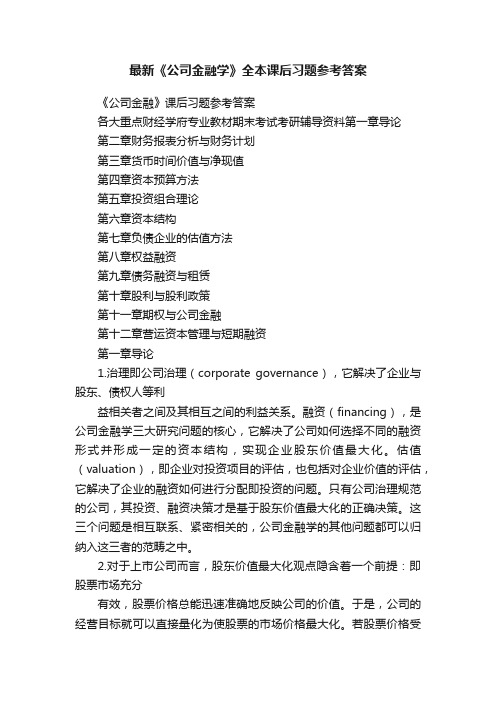
最新《公司金融学》全本课后习题参考答案《公司金融》课后习题参考答案各大重点财经学府专业教材期末考试考研辅导资料第一章导论第二章财务报表分析与财务计划第三章货币时间价值与净现值第四章资本预算方法第五章投资组合理论第六章资本结构第七章负债企业的估值方法第八章权益融资第九章债务融资与租赁第十章股利与股利政策第十一章期权与公司金融第十二章营运资本管理与短期融资第一章导论1.治理即公司治理(corporate governance),它解决了企业与股东、债权人等利益相关者之间及其相互之间的利益关系。
融资(financing),是公司金融学三大研究问题的核心,它解决了公司如何选择不同的融资形式并形成一定的资本结构,实现企业股东价值最大化。
估值(valuation),即企业对投资项目的评估,也包括对企业价值的评估,它解决了企业的融资如何进行分配即投资的问题。
只有公司治理规范的公司,其投资、融资决策才是基于股东价值最大化的正确决策。
这三个问题是相互联系、紧密相关的,公司金融学的其他问题都可以归纳入这三者的范畴之中。
2.对于上市公司而言,股东价值最大化观点隐含着一个前提:即股票市场充分有效,股票价格总能迅速准确地反映公司的价值。
于是,公司的经营目标就可以直接量化为使股票的市场价格最大化。
若股票价格受到企业经营状况以外的多种因素影响,那么价值确认体系就存在偏差。
因此,以股东价值最大化为目标必须克服许多公司不可控的影响股价的因素。
第二章财务报表分析与财务计划1.资产负债表;利润表;所有者权益变动表;现金流量表。
资产= 负债+ 所有者权益2.我国的利润表采用“多步式”格式,分为营业收入、营业利润、利润总额、净利润、每股收益、其他综合收益和综合收益总额等七个盈利项目。
3.直接法是按现金收入和支出的主要类别直接反映企业经营活动产生的现金流量,一般以利润表中的营业收入为起算点,调整与经营活动有关项目的增减变化,然后计算出经营活动现金流量。
(完整版)《商业银行管理学》课后习题答案
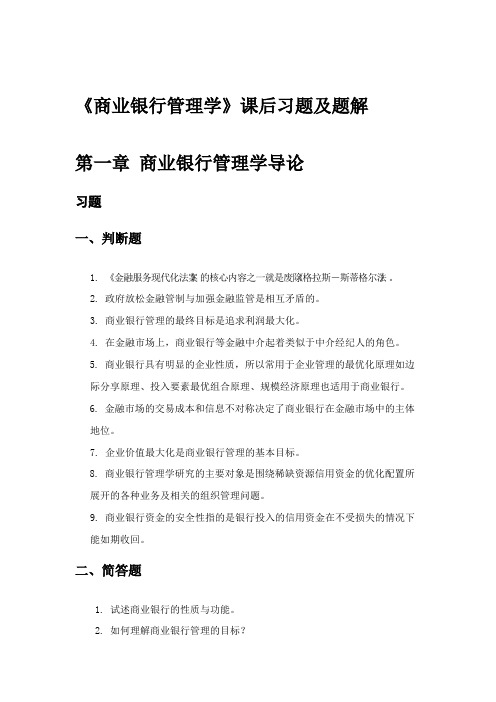
《商业银行管理学》课后习题及题解第一章商业银行管理学导论习题一、判断题1. 《金融服务现代化法案》的核心内容之一就是废除《格拉斯-斯蒂格尔法》。
2. 政府放松金融管制与加强金融监管是相互矛盾的。
3. 商业银行管理的最终目标是追求利润最大化。
4. 在金融市场上,商业银行等金融中介起着类似于中介经纪人的角色。
5. 商业银行具有明显的企业性质,所以常用于企业管理的最优化原理如边际分享原理、投入要素最优组合原理、规模经济原理也适用于商业银行。
6. 金融市场的交易成本和信息不对称决定了商业银行在金融市场中的主体地位。
7. 企业价值最大化是商业银行管理的基本目标。
8. 商业银行管理学研究的主要对象是围绕稀缺资源信用资金的优化配置所展开的各种业务及相关的组织管理问题。
9. 商业银行资金的安全性指的是银行投入的信用资金在不受损失的情况下能如期收回。
二、简答题1. 试述商业银行的性质与功能。
2. 如何理解商业银行管理的目标?3. 现代商业银行经营的特点有哪些?4. 商业银行管理学的研究对象和内容是什么?5. 如何看待“三性”平衡之间的关系?三、论述题1. 论述商业银行的三性目标是什么,如何处理三者之间的关系。
2. 试结合我国实际论述商业银行在金融体系中的作用。
第一章习题参考答案一、判断题1.√2.×3.×4.√5.×6.√7.×8.√9.√二、略;三、略。
第二章商业银行资本金管理习题一、判断题1. 新巴塞尔资本协议规定,商业银行的核心资本充足率仍为4%。
2. 巴塞尔协议规定,银行附属资本的合计金额不得超过其核心资本的50%。
3. 新巴塞尔资本协议对银行信用风险提供了两种方法:标准法和内部模型法。
4. 资本充足率反映了商业银行抵御风险的能力。
5. 我国国有商业银行目前只能通过财政增资的方式增加资本金。
6. 商业银行计算信用风险加权资产的标准法中的风险权重由监管机关规定。
二、单选题1. 我国《商业银行资本充足率管理办法》规定,计入附属资本的长期次级债务不得超过核心资本的。
第十章课后习题答案
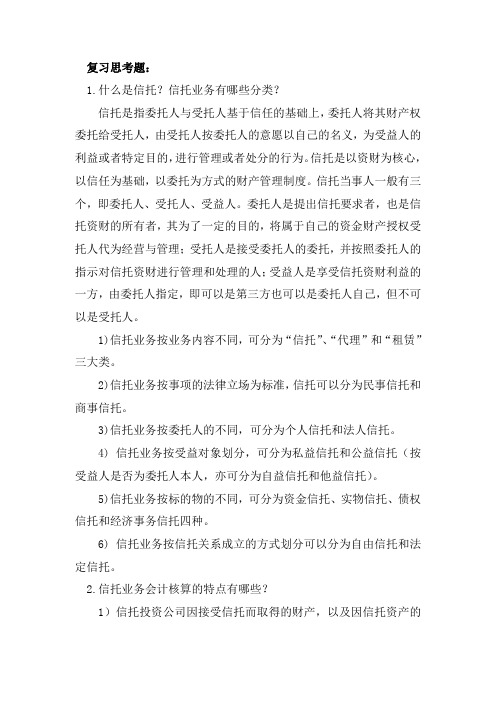
复习思考题:1.什么是信托?信托业务有哪些分类?信托是指委托人与受托人基于信任的基础上,委托人将其财产权委托给受托人,由受托人按委托人的意愿以自己的名义,为受益人的利益或者特定目的,进行管理或者处分的行为。
信托是以资财为核心,以信任为基础,以委托为方式的财产管理制度。
信托当事人一般有三个,即委托人、受托人、受益人。
委托人是提出信托要求者,也是信托资财的所有者,其为了一定的目的,将属于自己的资金财产授权受托人代为经营与管理;受托人是接受委托人的委托,并按照委托人的指示对信托资财进行管理和处理的人;受益人是享受信托资财利益的一方,由委托人指定,即可以是第三方也可以是委托人自己,但不可以是受托人。
1)信托业务按业务内容不同,可分为“信托”、“代理”和“租赁”三大类。
2)信托业务按事项的法律立场为标准,信托可以分为民事信托和商事信托。
3)信托业务按委托人的不同,可分为个人信托和法人信托。
4) 信托业务按受益对象划分,可分为私益信托和公益信托(按受益人是否为委托人本人,亦可分为自益信托和他益信托)。
5)信托业务按标的物的不同,可分为资金信托、实物信托、债权信托和经济事务信托四种。
6) 信托业务按信托关系成立的方式划分可以分为自由信托和法定信托。
2.信托业务会计核算的特点有哪些?1)信托投资公司因接受信托而取得的财产,以及因信托资产的管理、处分或者其他情形而取得的财产,称为信托资产。
信托资产不属于信托投资公司的自有财产,也不属于信托投资公司对受益人的负债。
信托投资公司终止时,信托资产不属于其清算资产。
2)信托投资公司的自有资产与信托资产应分开管理、分别核算。
信托投资公司管理不同类型的信托业务,应分别按项目设置信托业务明细账进行核算管理。
3)信托投资公司对不同信托资产按来源和运用设置相应会计科目进行核算反映。
来源类科目应按类别、委托人等设置明细账。
具体分为短期信托资产来源、长期信托资产来源。
短期信托资产来源指不超过一年的信托资产来源,包括短期信托存款、代扣代缴税金、待分配信托收益、应付受托人收益及应付其他受益人款项等。
金融机构管理课后答案

金融机构管理课后答案金融机构管理课后答案【篇一:金融机构管理习题答案020】txt>capital adequacychapter outlineintroductioncapital and insolvency riskcapitalthe market value of capitalthe book value of capitalthe discrepancy between the market and book values of equityarguments against market value accountingcapital adequacy in the commercial banking and thrift industryactual capital rulesthe capital-assets ratio (or leverage ratio)risk-based capital ratioscalculating risk-based capital ratioscapital requirements for other fissecurities firmslife insuranceproperty-casualty insurancesummaryappendix 20a: internal ratings based approach to measuring credit risk-adjusted assetssolutions for end-of-chapter questions and problems: chapter twenty1. identify and briefly discuss the importance of the fivefunctions of an fi’s capital?capital serves as a primary cushion against operating losses and unexpected losses in the value of assets (such as the failure of a loan). fis need to hold enough capital to provide confidence to uninsured creditors that they can withstand reasonable shocks to the value of their assets. in addition, the fdic, which guarantees deposits, is concerned that sufficient capital is held so that their funds are protected, because they are responsible for paying insured depositors in the event of a failure. this protection of the fdic funds includes the protectionof the fi owners against increases in insurance premiums. finally, capital also serves as a source of financing to purchase and invest in assets.financial institution?regulators are concerned with the levels of capital held by an fi because of its special role in society. a failure of an fi can have severe repercussions to the local or national economy unlike non-financial institutions. such externalities impose a burden on regulators to ensure that these failures do not impose major negative externalities on the economy. higher capital levels will reduce the probability of such failures.3. what are the differences between the economic definitionof capital and the book valuedefinition of capital?the book value definition of capital is the value of assets minus liabilities as found on the balance sheet. this amount often is referred to as accounting net worth. the economic definition of capital is the difference between the market value of assets and the market value of liabilities.a. how does economic value accounting recognize theadverse effects of credit andinterest rate risk?the loss in value caused by credit risk and interest rate risk is borne first by the equityholders, and then by the liability holders. in market value accounting, the adjustments to equity value are made simultaneously as the losses due to these risk elements occur. thus economic insolvency may be revealed before accounting value insolvency occurs.b. how does book value accounting recognize the adverse effects of credit and interestrate risk?because book value accounting recognizes the value of assets and liabilities at the timethey were placed on the books or incurred by the firm, losses are not recognized until the assets are sold or regulatory requirements force the firm to make balance sheet accounting adjustments. in the case of credit risk, these adjustments usually occur after all attempts tocollect or restructure the loans have occurred. in the case of interest rate risk, the change in interest rates will not affect the recognized accounting value of the assets or the liabilities.4. a financial intermediary has the following balance sheet (in millions) with all assets and liabilities in market values:6 percent semiannual 4-year 5 percent 2-year subordinated debt treasury notes (par value $12) $10(par value $25) $207 percent annual 3-yearaa-rated bonds (par=$15) $159 percent annual 5-yearbbb rated bonds (par=$15) equity capital total assets totalliabilities equitya. under fasb statement no. 115, what would be the effect on equity capital (net worth)if interest rates increase by 30 basis points? the t-notes are held for trading purposes, the rest are all classified as held to maturity.only assets that are classified for trading purposes or available-for-sale are to be reported atmarket values. those classified as held-to-maturity are reported at book values. thechange in value of the t-notes for a 30 basis points change in interest rates is:$10 = pvan=8,k=?($0.36) + pvn=8,k=?($12) ? k = 5.6465 x 2 = 11.293%if k =11.293% + 0.30% =11.593/2 = 5.7965%, the value of the notes will decline to: pvan=8,k=5.7965($0.36) +pvn=3,k=5.7965($12) = $9.8992. and the change in value is $9.8992 -$10 = -0.1008 x $1,000,000 = $100,770.396% semiannual 4-year 5% 2-year subordinatedt-notes (par value $12) $9.8992 debt (par value $25) $20.0000 7% annual 3-yearaa-rated bonds (par=$15) $15.0000 equity capital $20.0000 9% annual 5-yearbbb rated bonds (par=$15) adj. to equity total $39.8992 $39.8992b. under fasb statement no. 115, how are the changes in the market value of assetsadjusted in the income statements and balance sheets of fis?under fasb statement no. 115 assets held till maturity will bekept in book value. assetsavailable for sale and for trading purposes will always be reported in market values except by securities firms, which will have all assets and liabilities reported in market values. also, all uealized and realized income gains and losses will be reflected in both incomestatements and balance sheets for trading purposes. adjustments to assets available for sale will be reflected only through equity adjustments.5. why is the market value of equity a better measure of a banks ability to absorb losses thanbook value of equity?the market value of equity is more relevant than book value because in the event of abankruptcy, the liquidation (market) values will determine the fis ability to pay the various claimants.6. state bank has the following year-end balance sheet (in millions):cash $10 deposits $90loans equitytotal assetsthe loans primarily are fixed-rate, medium-term loans, while the deposits are either short-term or variable-rate. rising interest rates have caused the failure of a key industrialcompany, and as a result, 3 percent of the loans are considered to be uncollectable and thus have no economic value. one-third of these uncollectable loans will be charged off.further, the increase in interest rates has caused a 5 percent decrease in the market value of the remaining loans.a. what is the impact on the balance sheet after the necessaryadjustments are madeaccording to book value accounting? according to market value accounting?under book value accounting, the only adjustment is to charge off 1 percent of the loans.thus the loan portfolio will decrease by $0.90 and a corresponding adjustment will occur in the equity account.the new book value of equity will be $9.10. we assume no tax affects since the tax rate is not given.under market value accounting, the 3 percent decrease inloan value will be recognized, aswill the 5 percent decrease in market value of the remaining loans. thus equity willdecrease by 0.03 x $90 + 0.05 x $90(1 – 0.03) = $7.065. the new market value of equity will be $2.935.b. what is the new market to book value ratio if state bank has $1 million sharesoutstanding?the new market to book value ratio is $2.935/$9.10 = 0.3225.7. what are the arguments for and against the use of market value accounting for fis?market values produce a more accurate picture of the bank’s current financial position for both stockholders and regulators. stockholders can more easily see the effects of changes in interest rates on the bank’s equity, and they can evalua te more clearly the liquidation value of adistressed bank. among the arguments against market value accounting are that market values sometimes are difficult to estimate, particularly for small banks with non-traded assets. this argument is countered by the increasing use of assetsecuritization as a means to determine value of even thinly traded assets. in addition, some argue that market value accounting can produce higher volatility in the earnings of banks. a significant issue in this regard is that regulators may close a bank too quickly under the prompt corrective action requirements of fdicia.8. how is the leverage ratio for an fi defined?the leverage ratio is the ratio of book value of core capital to the book value of total assets, where core capital is book value of equity plus qualifying cumulative perpetual preferred stock plus minority interests in equity accounts of consolidated subsidiaries.9. what is the significance of prompt corrective action as specified by the fdicia legislation?the prompt corrective action provision requires regulators to appoint a receiver for the bank when the leverage ratio falls below 2 percent. thus even though the bank is technically not insolvent in terms of book value of equity, the institution can be placed into receivorship.10. identify and discuss the weaknesses of the leverage ratio as a measure of capital adequacy.first, closing a bank when the leverage ratio falls below 2 percent does not guarantee that the depositors are adequately protected. in many cases of financial distress, the actual market value of equity is significantly negative by the time the leverage ratio reaches 2 percent. second, using total assets as the denominator does not consider the different credit and interest rate risks of the individual assets. third, the ratio does not capture the contingent risk of the off-balance sheet activities of the bank.11. what is the basel agreement?the basel agreement identifies the risk-based capital ratios agreed upon by the member countries of the bank forinternational settlements. the ratios are to be implemented for all commercial banks under their jurisdiction. further, most countries in the world now have accepted the guidelines of this agreement for measuring capital adequacy.12. what is the major feature in the estimation of credit risk under the basel i capitalrequirements?the major feature of the basel agreement is that the capital of banks must be measured as an average of credit-risk-adjusted total assets both on and off the balance sheet.13. what is the total risk-based capital ratio?the total risk-based capital ratio divides total capital by the total of risk-adjusted assets. this ratio must be at least 8 percent for a bank to be considered adequately capitalized. further, at least 4 percent of the risk-based assets must be supported by core capital.【篇二:银行管理章节练习题(附答案)】以下关于金融工具的分类,错误的是()。
公司金融第八版中文课后习题答案

第一章 1.在所有权形式的公司中,股东是公司的所有者。
股东选举公司的董事会,董事会任命该公司的管理层。
企业的所有权和控制权分离的组织形式是导致的代理关系存在的主要原因。
管理者可能追求自身或别人的利益最大化,而不是股东的利益最大化。
在这种环境下,他们可能因为目标不一致而存在代理问题。
2.非营利公司经常追求社会或政治任务等各种目标。
非营利公司财务管理的目标是获取并有效使用资金以最大限度地实现组织的社会使命。
3.这句话是不正确的。
管理者实施财务管理的目标就是最大化现有股票的每股价值,当前的股票价值反映了短期和长期的风险、时间以及未来现金流量。
4.有两种结论。
一种极端,在市场经济中所有的东西都被定价。
因此所有目标都有一个最优水平,包括避免不道德或非法的行为,股票价值最大化。
另一种极端,我们可以认为这是非经济现象,最好的处理方式是通过政治手段。
一个经典的思考问题给出了这种争论的答案:公司估计提高某种产品安全性的成本是30美元万。
然而,该公司认为提高产品的安全性只会节省20美元万。
请问公司应该怎么做呢?” 5.财务管理的目标都是相同的,但实现目标的最好方式可能是不同的,因为不同的国家有不同的社会、政治环境和经济制度。
6.管理层的目标是最大化股东现有股票的每股价值。
如果管理层认为能提高公司利润,使股价超过35美元,那么他们应该展开对恶意收购的斗争。
如果管理层认为该投标人或其它未知的投标人将支付超过每股35美元的价格收购公司,那么他们也应该展开斗争。
然而,如果管理层不能增加企业的价值,并且没有其他更高的投标价格,那么管理层不是在为股东的最大化权益行事。
现在的管理层经常在公司面临这些恶意收购的情况时迷失自己的方向。
7.其他国家的代理问题并不严重,主要取决于其他国家的私人投资者占比重较小。
较少的私人投资者能减少不同的企业目标。
高比重的机构所有权导致高学历的股东和管理层讨论决策风险项目。
此外,机构投资者比私人投资者可以根据自己的资源和经验更好地对管理层实施有效的监督机制。
《商业银行经营管理》(第二版) 参考答案 第10章

第十章商业银行的兼并与收购复习思考题1.概念解释:银行兼并银行收购并购浪潮敌意收购标购拒鲨条款绿色邮包答:略。
2.结合第三章的内容,理解银行内部增长的限制因素?答:银行寻求内部增长构成最大威胁的有两个:1.是金融市场竞争加剧。
非银行金融机构侵入商业银行的传统业务市场,同时脱媒化影响了银行储蓄的市场规模,因此银行受破坏性竞争的压迫,其经营本钱逐步上升而效率逐渐下降,导致创利能力萎缩,资本的源泉枯竭。
2.?巴塞尔协议?规定的资本与风险资产比率不低于8%使银行难以靠同步扩大资产和负债规模来实现总资产规模的扩大,银行传统的金融产品生产规模受到限制。
3.银行兼并与收购的动机有哪些?答:获取协力优势是商业银行兼并与收购所希望到达的目标。
在现实中,商业银行兼并或收购他家银行的动机可以分为两大类,即防卫动机和侵袭动机。
1.防卫动机水平型兼并与收购的防卫动机。
包括节约本钱、提高市场份额、实现成长目标、增强综合实力等。
混合型兼并与收购的防卫动机。
混合型兼并与收购的防卫动机主要有两种,即分散行业风险和寻找新兴产业替代衰落产业。
2.侵袭动机。
当一家商业银行看到某一目标对象存在致命弱点而将之定为猎物银行而发动兼并与收购时,我们就说它具备了侵袭动机。
怀着侵袭动机所发起的兼并与收购多属敌意收购〔Hostile Acquisition〕。
敌意收购的目的是为了在收购成功后将被收购企业拆零售卖。
猎物银行的低效资本结构,如拥有闲置的或使用效率不高的资本,也能勾起猎手银行的侵袭动机。
这类侵袭动机称为捕捉金融时机。
4.兼并与收购的区别是什么?答:兼并〔Merger〕是指当事人双方的两家银行的全部业务和资产合二为一,兼并后组成一家具有法人资格的新银行,而原来的两家银行均不再保持法人资格。
通常情况下,两家老银行不再独立存在,即使在某些兼并案例中继续存在,但均受控于新银行。
新诞生的银行由原来两家银行的股东联合拥有,新银行的管理层受股东大会所托管理业务和资产运作。
金融机构管理第十章中文版课后习题答案(1-8、19)

金融机构管理第十章中文版课后习题答案(1-8、19)1.市场风险是指由于市场条件,例如资产价值、利率、市场波动性与市场流动性的变化而给金融机构交易资产组合的盈利所带来的不确定性风险。
2.市场风险测量的重要性:a.管理信息,市场风险测量能向高级管理人员提供交易员所承担的风险敞口的信息。
b.设定限额,市场风险测量可以在每个交易领域设定每位交易员在经济上合理的头寸限额。
c.资源分配,市场风险测量可以识别每单位风险有着最大潜在的回报的领域,从而向这个领域导入更多的资本与资源。
d.业绩评估,市场风险测量可以计算交易员的风险回报比率,提供一个更合理的奖惩制度。
e.监管,市场风险测量能够指出由于谨慎监管而导致的潜在的资源配置不当。
3 .日风险收益是指一日内,在利率变化、汇率变化、市场波动等不利环境下对投资组合估计的潜在损失。
日风险收益=头寸的美元市值*该头寸的价格敏感性*收益率潜在的不利变动=头寸的美元市值*价格波动性。
价格波动性即价格敏感性乘以收益率的不利变动。
4. a. MD = 5 ÷ (1.07) = 4.6729 年b . 收益率的不利变动= 1.65σ = 1.65 x 0.0012 = .001980c. 价格波动性= -MD x 收益率的不利变动= -4.6729 x .00198 = -0.009252 或-0.9252 %d. DEAR = 头寸的美元市值x价格波动性= $1,000,000 x 0.009252 = $9,2525. 风险价值是指一段时间内累积的日风险收益。
V AR = DEAR x [N]½.=$9,252 x3.1623 = $29,257.39.这个公式假设收益率的冲击式独立的,即这一天发生的损失不会影响到下一天的收益,但这种假设是不严谨的。
事实上,市场上每天的变动都是相互联系的。
6. 10天的:VAR = 8,500 x [10]½ = 8,500 x 3.1623 = $26,879.3620天的V AR = 8,500 x [20]½= 8,500 x 4.4721 = $38,013.16V AR20≠ (2 x VAR10) 的原因:随着时间的推移,一件不利的事情对每天的影响是逐渐减少的。
上交大《金融学》第十章 课后习题答案
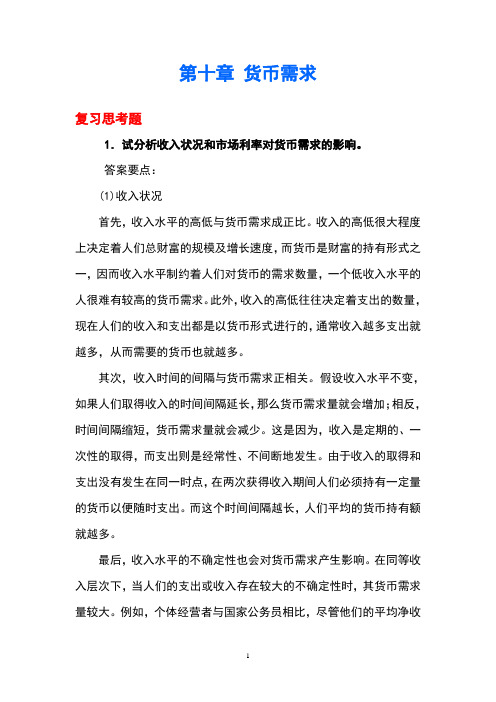
第十章货币需求复习思考题1.试分析收入状况和市场利率对货币需求的影响。
答案要点:(1)收入状况首先,收入水平的高低与货币需求成正比。
收入的高低很大程度上决定着人们总财富的规模及增长速度,而货币是财富的持有形式之一,因而收入水平制约着人们对货币的需求数量,一个低收入水平的人很难有较高的货币需求。
此外,收入的高低往往决定着支出的数量,现在人们的收入和支出都是以货币形式进行的,通常收入越多支出就越多,从而需要的货币也就越多。
其次,收入时间的间隔与货币需求正相关。
假设收入水平不变,如果人们取得收入的时间间隔延长,那么货币需求量就会增加;相反,时间间隔缩短,货币需求量就会减少。
这是因为,收入是定期的、一次性的取得,而支出则是经常性、不间断地发生。
由于收入的取得和支出没有发生在同一时点,在两次获得收入期间人们必须持有一定量的货币以便随时支出。
而这个时间间隔越长,人们平均的货币持有额就越多。
最后,收入水平的不确定性也会对货币需求产生影响。
在同等收入层次下,当人们的支出或收入存在较大的不确定性时,其货币需求量较大。
例如,个体经营者与国家公务员相比,尽管他们的平均净收入水平相同,但个体经营者的收入波动较大,在面临经营风险的同时,还要考虑自身的医疗、养老等保障,预期以外的支出可能性较大,因此,通常会持有更多的货币;而公务员收入较稳定,相关保障比较完善,所以他可以很好地控制自己平时的支出,持有的货币量会较少。
(2)利率水平利率的变动对货币需求的影响也是非常大的。
在正常情况下,利率水平与货币需求呈负相关关系。
在现代经济中,人们在保有财富时,并不是只持有货币这一种形式,还可以持有其他金融资产。
货币的安全性和流动性虽然最高,但是与其他金融资产相比收益性却又相对较低。
所以在保有财富时,人们会综合考虑不同资产的收益性和流动性,来决定持有各种财富形式的比例,这种选择在很大程度上受市场利率变动的影响很大。
当市场利率上升时,人们持有货币的机会成本(即因持有货币而放弃的收益)就会增加,进而货币需求就会减少;反之,当市场利率下降时,货币需求增加。
金融学课后习题答案(已打印)
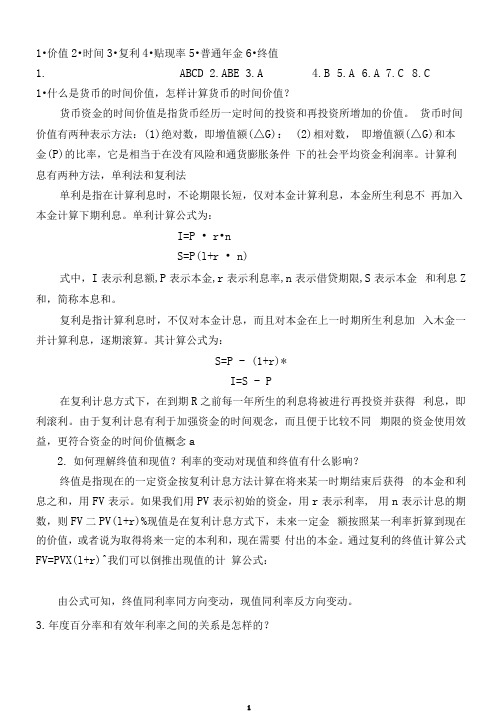
1•价值2•时间3•复利4•贴现率5•普通年金6•终值1.ABCD2.ABE3.A4.B5.A6.A7.C8.C 1•什么是货币的时间价值,怎样计算货币的时间价值?货币资金的时间价值是指货币经历一定时间的投资和再投资所增加的价值。
货币时间价值有两种表示方法:(1)绝对数,即增值额(△G): (2)相对数,即增值额(△G)和本金(P)的比率,它是相当于在没有风险和通货膨胀条件下的社会平均资金利润率。
计算利息有两种方法,单利法和复利法单利是指在计算利息时,不论期限长短,仅对本金计算利息,本金所生利息不再加入本金计算下期利息。
单利计算公式为:I=P • r•nS=P(l+r • n)式中,I表示利息额,P表示本金,r表示利息率,n表示借贷期限,S表示本金和利息Z 和,简称本息和。
复利是指计算利息时,不仅对本金计息,而且对本金在上一时期所生利息加入木金一并计算利息,逐期滚算。
其计算公式为:S=P - (1+r)*I=S - P在复利计息方式下,在到期R之前每一年所生的利息将被进行再投资并获得利息,即利滚利。
由于复利计息有利于加强资金的时间观念,而且便于比较不同期限的资金使用效益,更符合资金的时间价值概念a2.如何理解终值和现值?利率的变动对现值和终值有什么影响?终值是指现在的一定资金按复利计息方法计算在将来某一时期结束后获得的本金和利息之和,用FV表示。
如果我们用PV表示初始的资金,用r表示利率, 用n表示计息的期数,则FV二PV(l+r)%现值是在复利计息方式下,未來一定金额按照某一利率折算到现在的价值,或者说为取得将来一定的本利和,现在需要付出的本金。
通过复利的终值计算公式FV=PVX(l+r)^我们可以倒推出现值的计算公式:由公式可知,终值同利率同方向变动,现值同利率反方向变动。
3.年度百分率和有效年利率之间的关系是怎样的?年度百分比率(annual percent age rate, APR )是指银行等金融机构提供 的利率,也叫做报价利率。
金融学(本)第十章的形考题及答案
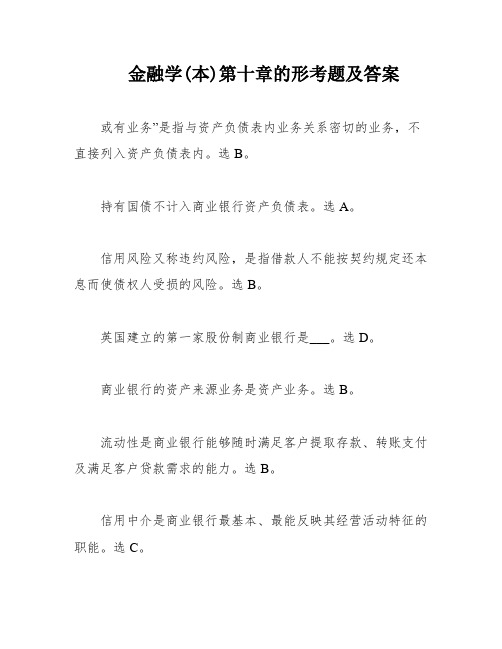
金融学(本)第十章的形考题及答案或有业务”是指与资产负债表内业务关系密切的业务,不直接列入资产负债表内。
选B。
持有国债不计入商业银行资产负债表。
选A。
信用风险又称违约风险,是指借款人不能按契约规定还本息而使债权人受损的风险。
选B。
英国建立的第一家股份制商业银行是___。
选D。
商业银行的资产来源业务是资产业务。
选B。
流动性是商业银行能够随时满足客户提取存款、转账支付及满足客户贷款需求的能力。
选B。
信用中介是商业银行最基本、最能反映其经营活动特征的职能。
选C。
核心资本是银行真正意义上的自有资金。
选A。
总分行制是世界各国商业银行普遍采用的组织形式,具有经营范围广,规模大,分工细,能够有效运用资金并分散风险等优点。
选A。
风险识别是商业银行风险管理中揭示与认清风险,分析风险的起因与可能的后果的过程。
选C。
我国政策性银行的资金来源主要靠财政划拨与发行金融债券。
选C。
控股公司制是由一家控股公司持有一家或多家银行的股份,或者控股公司下设多个子公司的商业银行组织制度。
选B。
商业银行的资产业务包括贷款、证券投资、存款等表内业务,而负债业务则包括发行债券、吸收存款等表外业务。
商业银行的证券投资属于资产业务,是银行进行投资理财的一种方式。
根据巴塞尔协议的规定,商业银行的核心资本充足率不得低于8%,这是为了保证银行在面对风险时有足够的资本储备。
商业银行的贷款承诺、担保以及期货、期权等业务属于表外业务,虽然风险小,但收益也相对较低。
商业银行面临的市场风险包括利率风险和汇率风险两种,这是由于银行经营的资产和负债之间存在着利率和汇率的敏感性。
政策性银行不以营利为经营目标,但仍然奉行有偿借贷、保本微利的原则,以支持国家的经济发展和社会建设。
政策性银行的资金来源主要是吸收存款,此外也可以和债券进行筹资,以满足其业务和发展的需要。
风险管理与金融机构课后附加题参考答案(中文版)

风险管理与金融机构第四版约翰·C·赫尔附加问题(Further Problems)的答案第一章:导论1.15.假设一项投资的平均回报率为8%,标准差为14%。
另一项投资的平均回报率为12%,标准差为20%。
收益率之间的相关性为0.3。
制作一张类似于图1.2的图表,显示两项投资的其他风险回报组合。
答:第一次投资w1和第二次投资w2=1-w1的影响见下表。
可能的风险回报权衡范围如下图所示。
w1 w2μp σp0.0 1.0 12% 20%0.2 0.8 11.2% 17.05%0.4 0.6 10.4% 14.69%0.6 0.4 9.6% 13.22%0.8 0.2 8.8% 12.97%1.0 0.0 8.0% 14.00%1.16.市场预期收益率为12%,无风险收益率为7%。
市场收益率的标准差为15%。
一个投资者在有效前沿创建一个投资组合,预期回报率为10%。
另一个是在有效边界上创建一个投资组合,预期回报率为20%。
两个投资组合的回报率的标准差是多少?答:在这种情况下,有效边界如下图所示。
预期回报率为10%时,回报率的标准差为9%。
与20%的预期回报率相对应的回报率标准差为39%。
1.17.一家银行估计, 其明年利润正态分布, 平均为资产的0.8%,标准差为资产的2%。
公司需要多少股本(占资产的百分比):(a)99%确定其在年底拥有正股本;(b)99.9%确定其在年底拥有正股本?忽略税收。
答:(一)银行可以99%确定利润将优于资产的0.8-2.33×2或-3.85%。
因此,它需要相当于资产3.85%的权益,才能99%确定它在年底的权益为正。
(二)银行可以99.9%确定利润将大于资产的0.8-3.09×2或-5.38%。
因此,它需要权益等于资产的5.38%,才能99.9%确定它在年底将拥有正权益。
1.18.投资组合经理维持了一个积极管理的投资组合,beta值为0.2。
金融机构管理课后习题答案
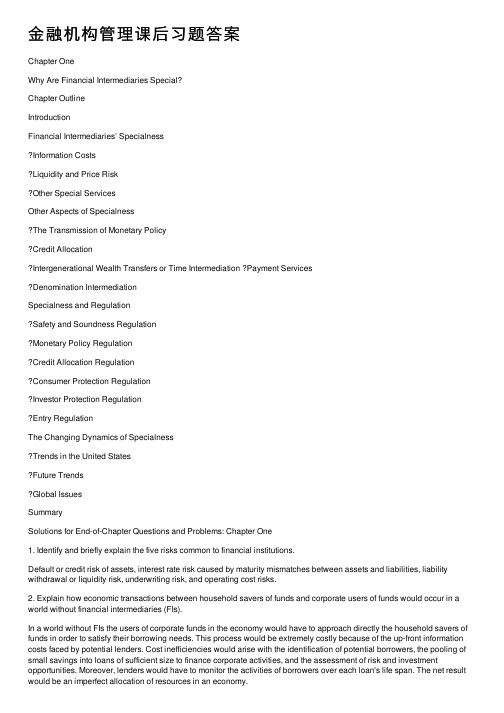
⾦融机构管理课后习题答案Chapter OneWhy Are Financial Intermediaries Special?Chapter OutlineIntroductionFinancial Intermediaries’ SpecialnessInformation CostsLiquidity and Price RiskOther Special ServicesOther Aspects of SpecialnessThe Transmission of Monetary PolicyCredit AllocationIntergenerational Wealth Transfers or Time Intermediation Payment ServicesDenomination IntermediationSpecialness and RegulationSafety and Soundness RegulationMonetary Policy RegulationCredit Allocation RegulationConsumer Protection RegulationInvestor Protection RegulationEntry RegulationThe Changing Dynamics of SpecialnessTrends in the United StatesFuture TrendsGlobal IssuesSummarySolutions for End-of-Chapter Questions and Problems: Chapter One1. Identify and briefly explain the five risks common to financial institutions.Default or credit risk of assets, interest rate risk caused by maturity mismatches between assets and liabilities, liability withdrawal or liquidity risk, underwriting risk, and operating cost risks.2. Explain how economic transactions between household savers of funds and corporate users of funds would occur in a world without financial intermediaries (FIs).In a world without FIs the users of corporate funds in the economy would have to approach directly the household savers of funds in order to satisfy their borrowing needs. This process would be extremely costly because of the up-front information costs faced by potential lenders. Cost inefficiencies would arise with the identification of potential borrowers, the pooling of small savings into loans of sufficient size to finance corporate activities, and the assessment of risk and investment opportunities. Moreover, lenders would have to monitor the activities of borrowers over each loan's life span. The net result would be an imperfect allocation of resources in an economy.3. Identify and explain three economic disincentives that probably would dampen the flow offunds between household savers of funds and corporate users of funds in an economic world without financial intermediaries.Investors generally are averse to purchasing securities directly because of (a) monitoring costs, (b) liquidity costs, and (c) price risk. Monitoring the activities of borrowers requires extensive time, expense, and expertise. As a result, households would prefer to leave this activity to others, and by definition, the resulting lack of monitoring would increase the riskiness of investing in corporate debt and equity markets. The long-term nature of corporate equity and debt would likely eliminate at least a portion of those households willing to lend money, as the preference of many for near-cash liquidity would dominate the extra returns which may be available. Third, the price risk of transactions on the secondary markets would increase without the information flows and services generated by high volume.4. Identify and explain the two functions in which FIs may specialize that enable the smoothflow of funds from household savers to corporate users.FIs serve as conduits between users and savers of funds by providing a brokerage function and by engaging in the asset transformation function. The brokerage function can benefit both savers and users of funds and can vary according to the firm. FIs may provide only transaction services, such as discount brokerages, or they also may offer advisory services which help reduce information costs, such as full-line firms like Merrill Lynch. The asset transformation function is accomplished by issuing their own securities, such as deposits and insurance policies that are more attractive to household savers, and using the proceeds to purchase the primary securities ofcorporations. Thus, FIs take on the costs associated with the purchase of securities.5. In what sense are the financial claims of FIs considered secondary securities, while thefinancial claims of commercial corporations are considered primary securities? How does the transformation process, or intermediation, reduce the risk, or economic disincentives, to the savers?The funds raised by the financial claims issued by commercial corporations are used to invest in real assets. These financial claims, which are considered primary securities, are purchased by FIs whose financial claims therefore are considered secondary securities. Savers who invest in the financial claims of FIs are indirectly investing in the primary securities of commercial corporations. However, the information gathering and evaluation expenses, monitoring expenses, liquidity costs, and price risk of placing the investments directly with the commercial corporation are reduced because of the efficiencies of the FI.6. Explain how financial institutions act as delegated monitors. What secondary benefitsoften accrue to the entire financial system because of this monitoring process?By putting excess funds into financial institutions, individual investors give to the FIs the responsibility of deciding who should receive the money and of ensuring that the money is utilized properly by the borrower. In this sense the depositors have delegated the FI to act as a monitor on their behalf. The FI can collect information more efficiently than individual investors. Further, the FI can utilize this information to create new products, such as commercial loans, that continually update the information pool. This more frequent monitoring process sends important informational signals to other participants in the market, a process that reduces information imperfection and asymmetry between the ultimate sources and users of funds in the economy.7. What are five general areas of FI specialness that are caused by providing various servicesto sectors of the economy?First, FIs collect and process information more efficiently than individual savers. Second, FIs provide secondary claims to household savers which often have better liquidity characteristics than primary securities such as equities and bonds. Third, by diversifying the asset base FIs provide secondary securities with lower price-risk conditions than primary securities. Fourth, FIs provide economies of scale in transaction costs because assets are purchased in larger amounts. Finally, FIs provide maturity intermediation to the economy which allows the introduction of additional types of investment contracts, such as mortgage loans, that are financed with short-term deposits.8. How do FIs solve the information and related agency costs when household savers investdirectly in securities issued by corporations? What are agency costs?Agency costs occur when owners or managers take actions that are not in the best interests of the equity investor or lender.These costs typically result from the failure to adequately monitor theactivities of the borrower. If no other lender performs these tasks, the lender is subject to agency costs as the firm may not satisfy the covenants in the lending agreement. Because the FI invests the funds of many small savers, the FI has a greater incentive to collect information and monitor the activities of the borrower.9. What often is the benefit to the lenders, borrowers, and financial markets in general of thesolution to the information problem provided by the large financial institutions?One benefit to the solution process is the development of new secondary securities that allow even further improvements in the monitoring process. An example is the bank loan that is renewed more quickly than long-term debt. The renewal process updates the financial and operating information of the firm more frequently, thereby reducing the need for restrictive bond covenants that may be difficult and costly to implement.10. How do FIs alleviate the problem of liquidity risk faced by investors who wish to invest inthe securities of corporations?Liquidity risk occurs when savers are not able to sell their securities on demand. Commercial banks, for example, offer deposits that can be withdrawn at any time. Yet the banks make long-term loans or invest in illiquid assets because they are able to diversify their portfolios and better monitor the performance of firms that have borrowed or issued securities. Thus individual investors are able to realize the benefits of investing in primary assets without accepting the liquidity risk of direct investment.11. How do financial institutions help individual savers diversify their portfolio risks? Whichtype of financial institution is best able to achieve this goal?Money placed in any financial institution will result in a claim on a more diversified portfolio. Banks lend money to many different types of corporate, consumer, and government customers, and insurance companies have investments in many different types of assets. Investment in a mutual fund may generate the greatest diversification benefit because of the fund’s investment in a wide array of stocks and fixed income securities.12. How can financial institutions invest in high-risk assets with funding provided by low-riskliabilities from savers?Diversification of risk occurs with investments in assets that are not perfectly positively correlated. One result of extensive diversification is that the average risk of the asset base of an FI will be less than the average risk of the individual assets in which it has invested. Thus individual investors realize some of the returns of high-risk assets without accepting the corresponding risk characteristics.13. How can individual savers use financial institutions to reduce the transaction costs ofinvesting in financial assets?By pooling the assets of many small investors, FIs can gain economies of scale in transaction costs. This benefit occurs whether the FI is lending to a corporate or retail customer, or purchasing assets in the money and capital markets. In either case, operating activities that are designed to deal in large volumes typically are more efficient than those activities designed for small volumes.14. What is maturity intermediation? What are some of the ways in which the risks ofmaturity intermediation are managed by financial intermediaries?If net borrowers and net lenders have different optimal time horizons, FIs can service both sectors by matching their asset and liability maturities through on- and off-balance sheet hedging activities and flexible access to the financial markets. For example, the FI can offer the relatively short-term liabilities desired by households and also satisfy the demand for long-term loans such as home mortgages. By investing in a portfolio of long-and short-term assets that have variable- and fixed-rate components, the FI can reduce maturity risk exposure by utilizing liabilities that have similar variable- and fixed-rate characteristics, or by using futures, options, swaps, and other derivative products.15. What are five areas of institution-specific FI specialness, and which types of institutions aremost likely to be the service providers?First, commercial banks and other depository institutions are key players for the transmission of monetary policy from the central bank to the rest of the economy. Second, specific FIs often are identified as the major source of finance for certain sectors of the economy. For example, S&Ls and savings banks traditionally serve the credit needs of the residential real estate market. Third, life insurance and pension funds commonly are encouraged to provide mechanisms to transfer wealth across generations. Fourth, depository institutions efficiently provide payment services to benefit the economy. Finally, mutual funds provide denomination intermediation by allowing small investors to purchase pieces of assets with large minimum sizes such as negotiable CDs and commercial paper issues.16. How do depository institutions such as commercial banks assist in the implementation andtransmission of monetary policy?The Federal Reserve Board can involve directly the commercial banks in the implementation of monetary policy through changes in the reserve requirements and the discount rate. The open market sale and purchase of Treasury securities by the Fed involves the banks in the implementation of monetary policy in a less direct manner.17. What is meant by credit allocation regulation? What social benefit is this type ofregulation intended to provide?Credit allocation regulation refers to the requirement faced by FIs to lend to certain sectors of the economy, which are considered to be socially important. These may include housing and farming. Presumably the provision of credit to make houses more affordable or farms more。
《金融基础知识》第10章课后习题答案

精品行业资料,仅供参考,需要可下载并修改后使用!《金融基础知识》课后习题答案第10章习题答案1. 该公司应卖空的合约份数为:1.2×10,000,000/(500×270)=88.9≈89份2. 在τ时刻,期货价格和现货价格的关系为:()()f r r T F S e τττ--=假设保值比率为h, 则通过保值可以卖出的价格为:()()00()f r r T h F F S hF S hS eτττττ---+=+- 如果()()f r r T h eτ--=,则卖出的价格恒等于hF 0, 这时保值组合的方差为0。
也就证明了()()f r r T h e τ--=是最优保值比率。
3. 每份期货合约的价值为108.46875×1,000=108,468.75美元。
应该卖空的合约份数为:6,000,0008.259.760108,468.757.6⨯=≈份 4. 该银行可以与其他金融机构签订一份它支付固定利率、接受浮动利率的利率互换协议。
5. 当该投资组合的价值降到5400万美元时,你的资本损失为10%。
考虑到你在1年中得到了3%的现金红利,你的实际损失为7%。
令E (R P )表示投资组合的预期收益率,E(R I )表示指数的预期收益率,根据资本资产定价模型有:E(R P )-r f =β[E(R I )- r f ]因此当E(R P )=-7%时,E(R I )=[E(R P )-r f ]/ β+ r f =-1%。
由于指数1年的红利收益率等于3%,因此指数本身的预期变动率为-4%。
因此,当组合的价值降到5400万美元时,指数的预期值为0.96×300=288。
因此应购买协议价格等于288、期限1年的欧式看跌期权来保值。
所需的欧式看跌期权的数量为:2×60,000,000/(300×100)=4000份其中每份期权的规模为100美元乘以指数点。
